Solving Power Supply Stability Issues in Remote Agricultural Areas Based on an Improved Sliding-Mode Active Disturbance Rejection Control Method
Abstract
1. Introduction
2. Materials and Methods
2.1. DC Microgrid System
2.2. Second-Order Active Disturbance Rejection Controller Design
3. Improved Sliding-Mode Active Disturbance Rejection Control
3.1. Sliding-Mode Active Disturbance Rejection Control
3.2. Cascade Extended State Observer Design
3.3. Design of Non-Singular Fast Terminal Sliding-Mode Controller
4. Results
4.1. Photovoltaic Power Generation System
4.2. Normal Conditions
4.3. Photovoltaic Fluctuations Conditions
4.4. Load Fluctuations Conditions
5. Conclusions
Author Contributions
Funding
Institutional Review Board Statement
Data Availability Statement
Acknowledgments
Conflicts of Interest
Abbreviations
| ISMLADRC | Improved sliding-mode linear active disturbance rejection control |
| HESS | Hybrid energy storage system |
| SOC | State of charge |
| SOH | State of health |
| VSM | Virtual synchronous machine |
| CVCF | Constant voltage constant frequency |
| PI | Proportional–integral |
| ADRC | Active disturbance rejection control |
| ESO | Extended state observer |
| CLESO | Cascaded linear extended state observer |
| SMC | Sliding-mode control |
| PD | Proportional–derivative |
| PV | Photovoltaic |
| LADRC | Linear active disturbance rejection control |
| LESO | Linear extended state observer |
| NFTSMC | Non-singular fast terminal sliding-mode control |
| MPPT | Maximum power point tracking |
| INC | Incremental conductance |
References
- AI-Shetwi, A.Q. Sustainable development of renewable energy integrated power sector: Trends, environmental impacts, and recent challenges. Sci. Total Environ. 2022, 822, 153645. [Google Scholar]
- Farghali, M.; Osman, A.I.; Mohamed, I.M.; Chen, Z.; Chen, L.; Ihara, I.; Rooney, D.W. Strategies to save energy in the context of the energy crisis: A review. Environ. Chem. Lett. 2023, 21, 2003–2039. [Google Scholar]
- Chen, X.H.; Tee, K.; Elnahass, M.; Ahmed, R. Assessing the environmental impacts of renewable energy sources: A case study on air pollution and carbon emissions in China. J. Environ. Manag. 2023, 345, 118525. [Google Scholar]
- García Vera, Y.E.; Dufo-López, R.; Bernal-Agustín, J.L. Energy management in microgrids with renewable energy sources: A literature review. Appl. Sci. 2019, 9, 3854. [Google Scholar] [CrossRef]
- Sandelic, M.; Peyghami, S.; Sangwongwanich, A.; Blaabjerg, F. Reliability aspects in microgrid design and planning: Status and power electronics-induced challenges. Renew. Sustain. Energy Rev. 2022, 159, 112127. [Google Scholar]
- Fukaume, S.; Nagasaki, Y.; Tsuda, M. Stable power supply of an independent power source for a remote island using a Hybrid Energy Storage System composed of electric and hydrogen energy storage systems. Int. J. Hydrogen Energy 2022, 47, 13887–13899. [Google Scholar]
- Jin, J.X.; Zhang, T.L.; Yang, R.H.; Wang, J.; Mu, S.; Li, H. Hierarchical cooperative control strategy of distributed hybrid energy storage system in an island direct current microgrid. J. Energy Storage 2023, 57, 106205. [Google Scholar]
- Hall, P.J.; Bain, E.J. Energy-storage technologies and electricity generation. Energy Policy 2008, 36, 4352–4355. [Google Scholar]
- Hajiaghasi, S.; Salemnia, A.; Hamzeh, M. Hybrid energy storage system for microgrids applications: A review. J. Energy Storage 2019, 21, 543–570. [Google Scholar]
- Elmorshedy, M.F.; Subramaniam, U.; Mohamed Ali, J.S.; Almakhles, D. Energy management of hybrid DC microgrid with different levels of DC bus voltage for various load types. Energies 2023, 16, 5438. [Google Scholar] [CrossRef]
- Arévalo, P.; Ochoa-Correa, D.; Villa-Ávila, E. Towards Energy Efficiency: Innovations in High-Frequency Converters for Renewable Energy Systems and Electric Vehicles. Vehicles 2024, 7, 1. [Google Scholar] [CrossRef]
- Gopi, C.V.M.; Ramesh, R. Review of battery-supercapacitor hybrid energy storage systems for electric vehicles. Results Eng. 2024, 24, 103598. [Google Scholar] [CrossRef]
- Essa, M.E.S.M.; Ali, M.F.; El-kholy, E.E.; Amer, M.; Elsisi, M.; Sajjad, U.; Awad, H.E.S. Improving Micro-Grid Management: A Review of Integration of Supercapacitor across Different Operating Modes. Heliyon 2025, 11, e42178. [Google Scholar] [CrossRef] [PubMed]
- Jeyaraj, T.; Ponnusamy, A.; Selvaraj, D. Hybrid renewable energy systems stability analysis through future advancement technique: A review. Appl. Energy 2025, 383, 125355. [Google Scholar] [CrossRef]
- Liu, Z.; Luo, J.; Sun, Y.; Zhang, X.; Yan, Z. Advancing urban sustainability: Integrating renewable energy for accelerated zero-carbon community transitions. Front. Energy Res. 2024, 12, 1523257. [Google Scholar] [CrossRef]
- Rao, S.P.; Ranganathan, P.; Tomomewo, O.S. Hybrid Energy Storage Systems for Renewable Energy Integration: An Overview. In Proceedings of the 2024 56th North American Power Symposium (NAPS), El Paso, TX, USA, 13–15 October 2024; pp. 1–8. [Google Scholar]
- Azam, T.; Khalid, M.S.; Wu, Z.S. Lewis acid molten salt synthesis of 2D MXenes with fine-tuned surface terminations for energy storage and conversion. Mater. Today 2025, 78, 123–135. [Google Scholar] [CrossRef]
- Wang, X.; Wen, F. Optimal Planning and Operation in RES-Rich Power Systems under Electricity and Carbon Emission Market Environment. IEEE Trans. Sustain. Energy 2024, 15, 987–1001. [Google Scholar]
- Hirose, T.; Matsuo, H. Standalone hybrid wind-solar power generation system applying dump power control without dump load. IEEE Trans. Ind. Electron. 2011, 59, 988–997. [Google Scholar] [CrossRef]
- Sekhri, E.; Ibrahim, M.; Zequera, R.G.; Rassõlkin, A. Electric and Hybrid Vehicles: From Smart Energy Storage Systems to Mechanical Transmission. In Smart Electric and Hybrid Vehicles: Advancements in Materials, Design, Technologies, and Modeling; John Wiley & Sons, Inc.: Hoboken, NJ, USA, 2025; pp. 71–126. [Google Scholar] [CrossRef]
- Billanes, J.D.; Jørgensen, B.N.; Ma, Z. A Framework for Resilient Community Microgrids: Review of Operational Strategies and Performance Metrics. Energies 2025, 18, 405. [Google Scholar] [CrossRef]
- Çelik, D.; Khan, M.A.; Khosravi, N.; Waseem, M.; Ahmed, H. A review of energy storage systems for facilitating large-scale EV charger integration in electric power grid. J. Energy Storage 2025, 112, 115496. [Google Scholar] [CrossRef]
- Blanch-Fortuna, A.; Zambrano-Prada, D.; López-Santos, O.; Aroudi, A.E.; Vázquez-Seisdedos, L.; Martinez-Salamero, L. Hierarchical Control of Power Distribution in the Hybrid Energy Storage System of an Ultrafast Charging Station for Electric Vehicles. Energies 2024, 17, 1393. [Google Scholar] [CrossRef]
- Liu, X.; Chen, J.; Suo, Y.; Song, X.; Ju, Y. Active Disturbance Rejection Control Combined with Improved Model Predictive Control for Large-Capacity Hybrid Energy Storage Systems in DC Microgrids. Appl. Sci. 2024, 14, 8617. [Google Scholar] [CrossRef]
- Li, H.; Yao, T.; Zhang, X.; Bu, F.; Weng, L. Hybrid energy storage management strategy for electric propulsion aircraft based on three-step power distribution. World Electr. Veh. J. 2021, 12, 209. [Google Scholar] [CrossRef]
- Wang, C.; Lei, Z.; Huo, H.; Yao, G. Transient Stability Control Strategy Based on Uncertainty Quantification for Disturbances in Hybrid Energy Storage Microgrids. Appl. Sci. 2024, 14, 10212. [Google Scholar] [CrossRef]
- Peng, Z.; Cui, K.; Li, H.; Gu, N.; Liu, L.; Wang, D. Model-free antidisturbance autopilot design for autonomous surface vehicles with hardware-in-the-loop experiments. IEEE Trans. Ind. Inform. 2023, 20, 2387–2396. [Google Scholar]
- Fallaha, C.J.; Saad, M.; Kanaan, H.Y.; Al-Haddad, K. Sliding-mode robot control with exponential reaching law. IEEE Trans. Ind. Electron. 2010, 58, 600–610. [Google Scholar]
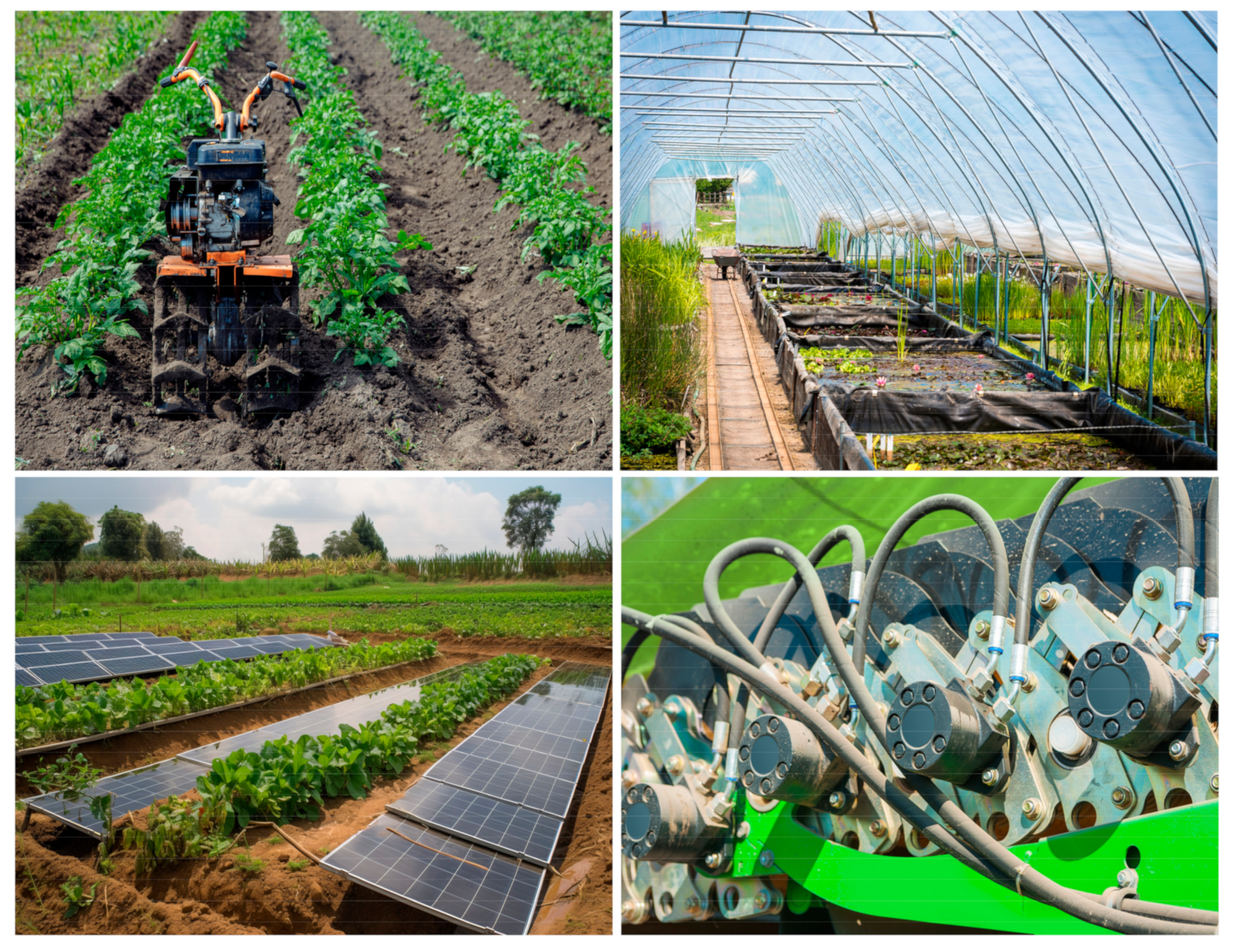
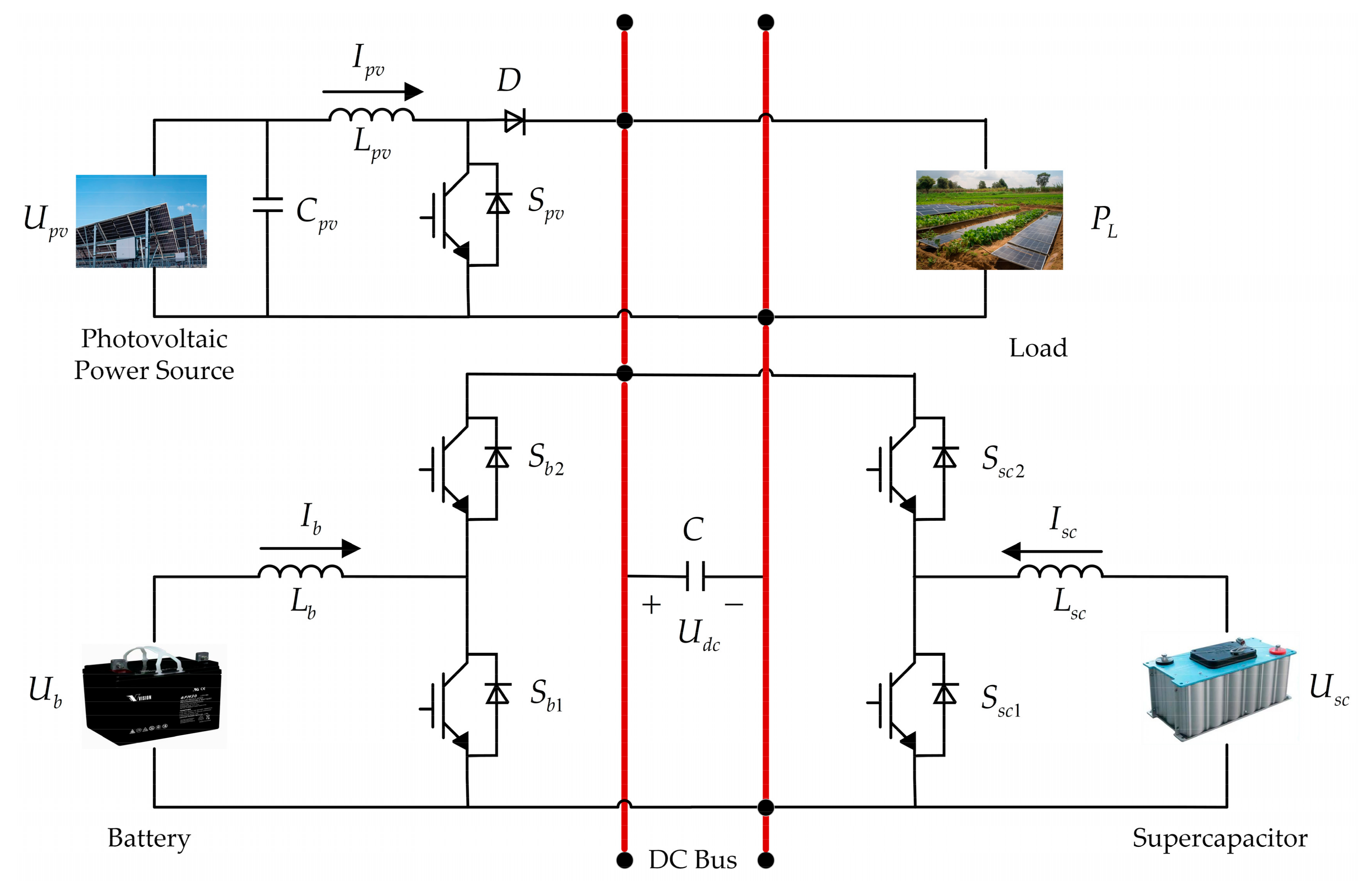
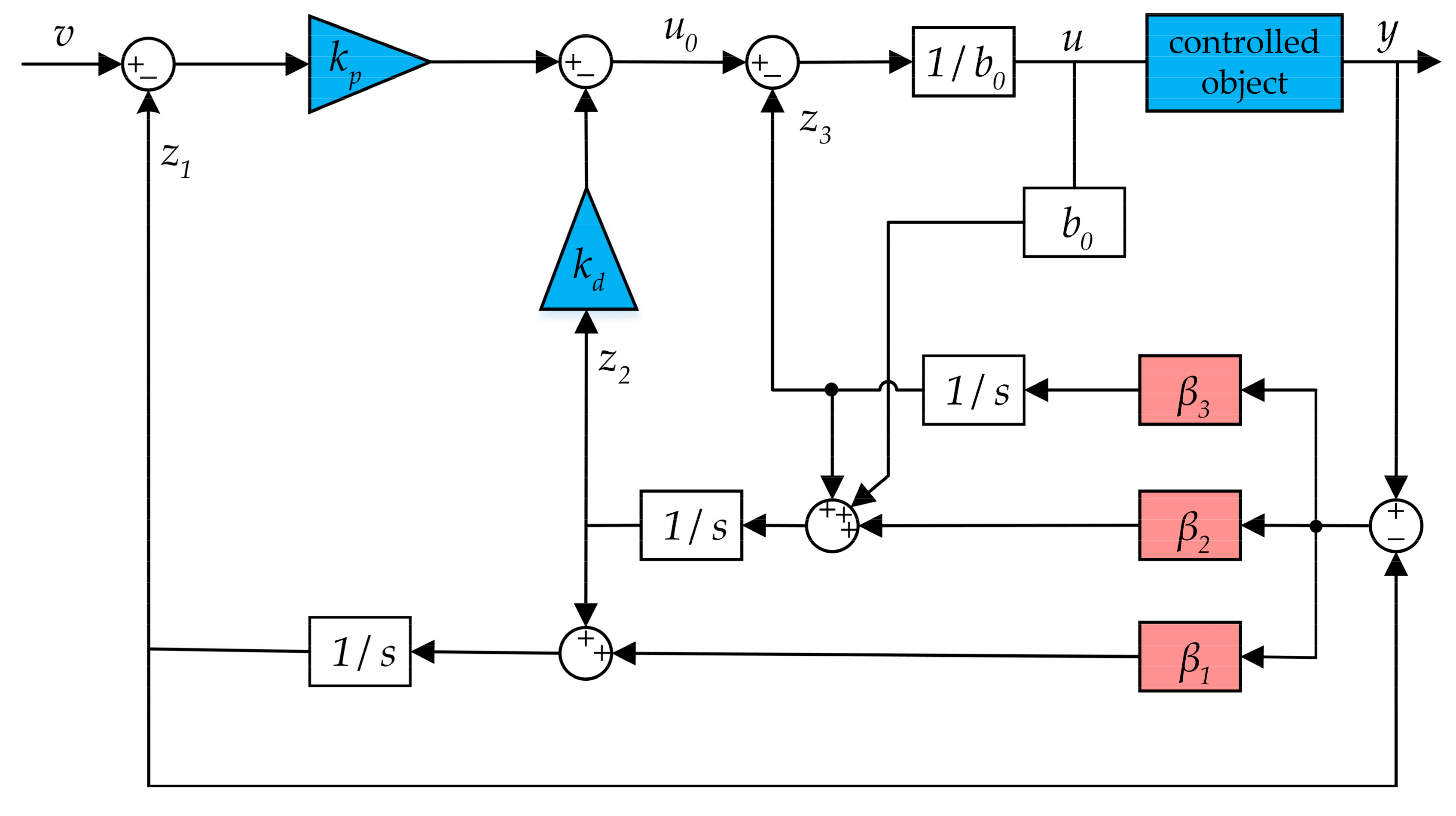

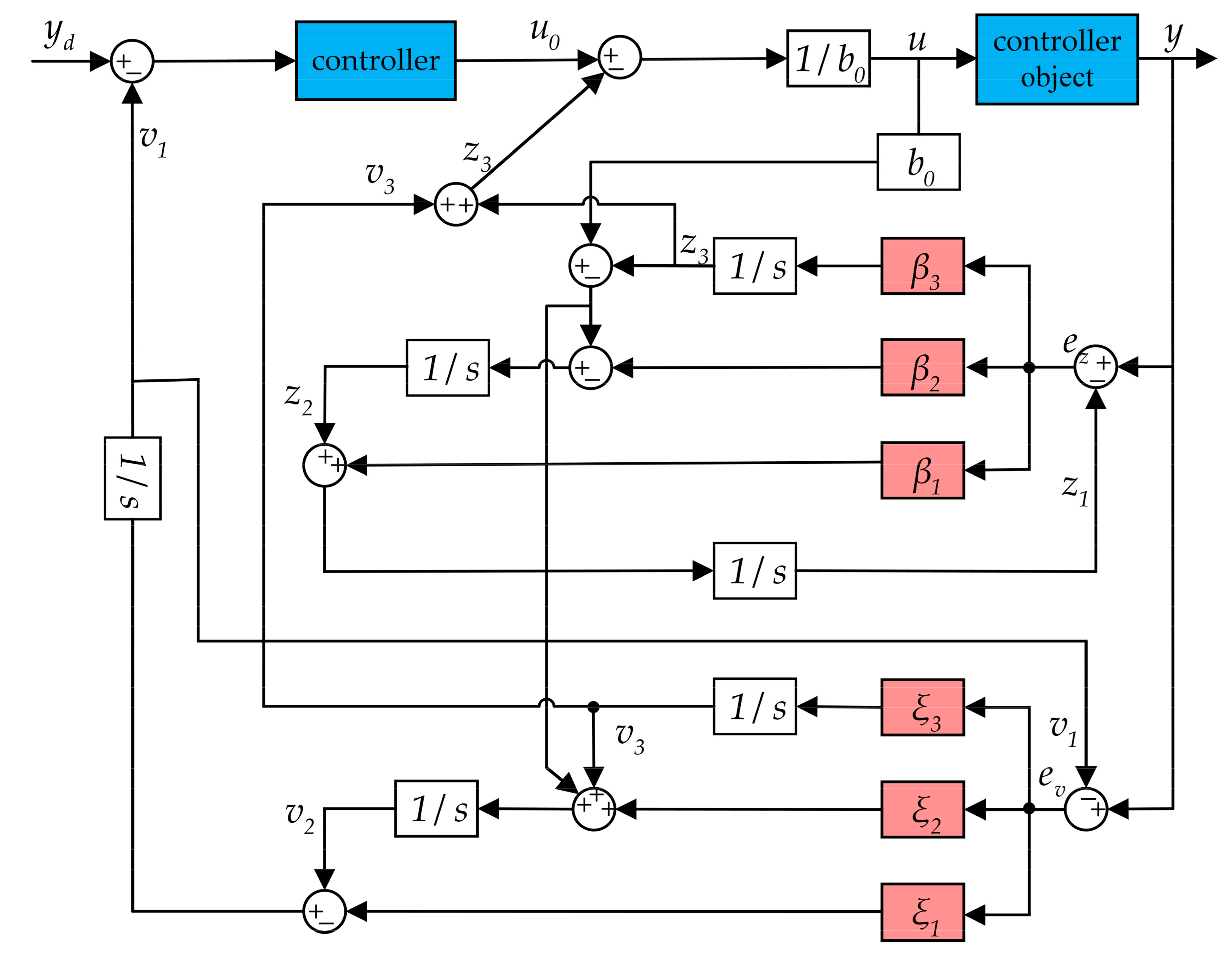
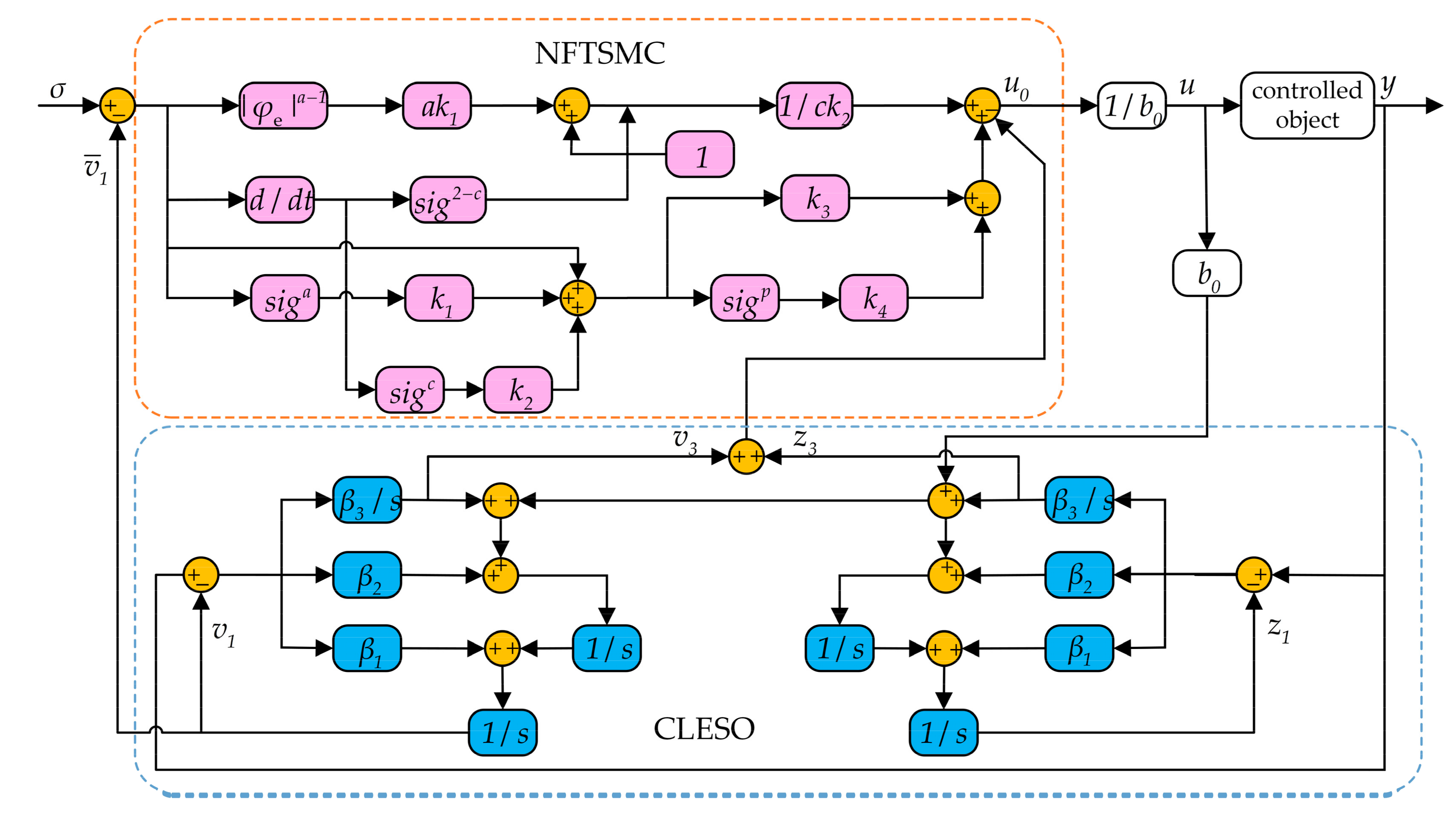
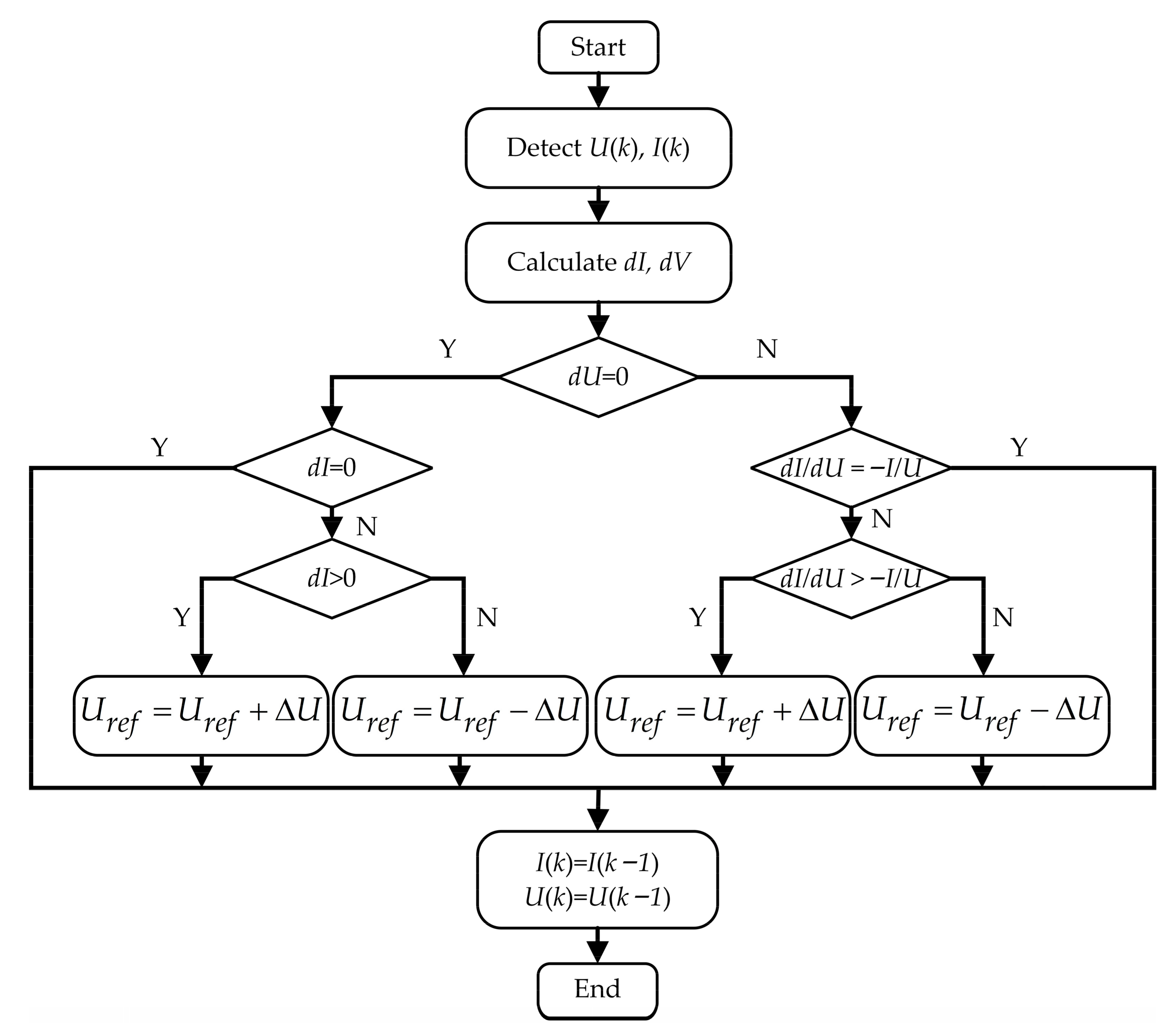


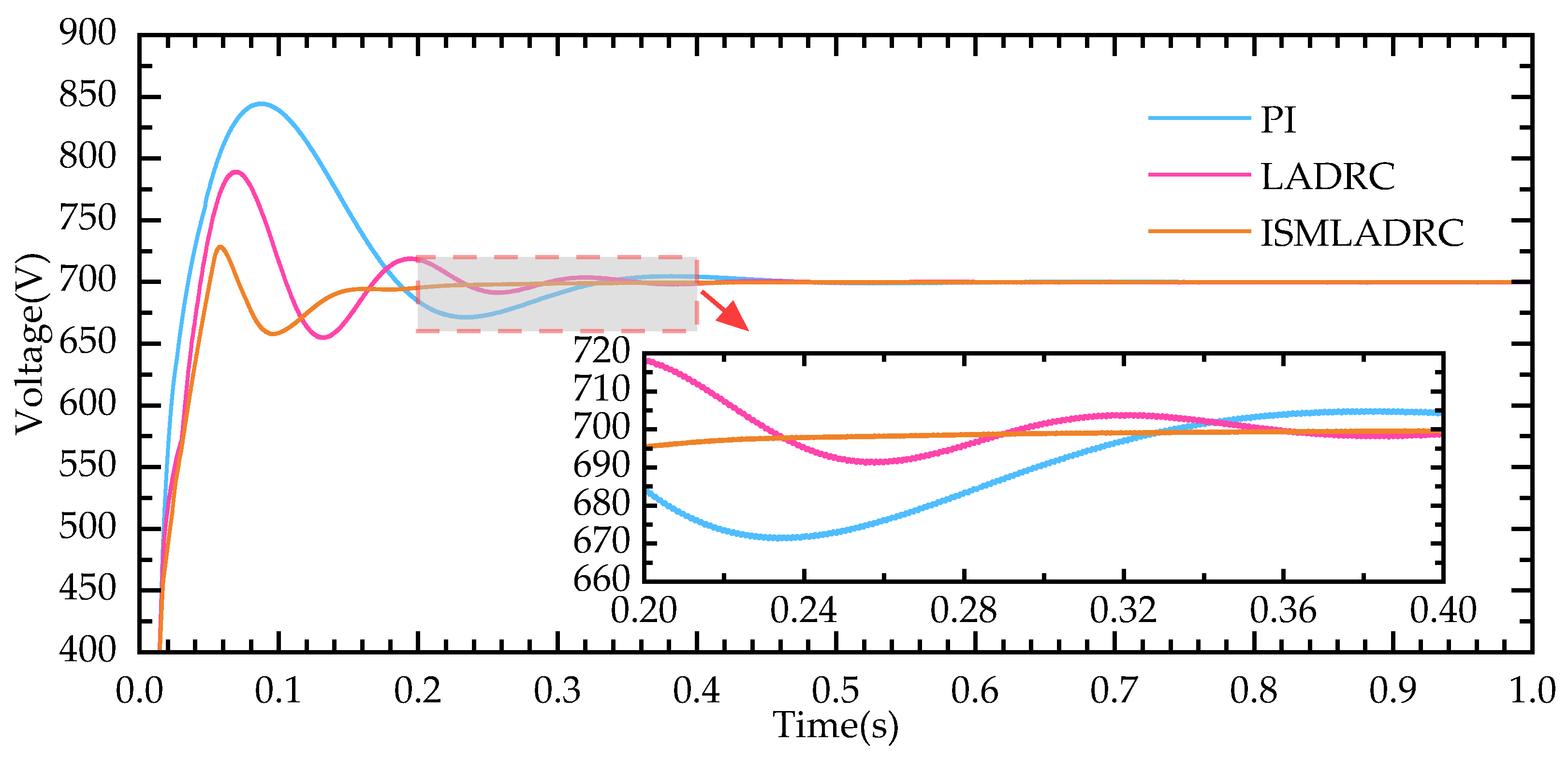
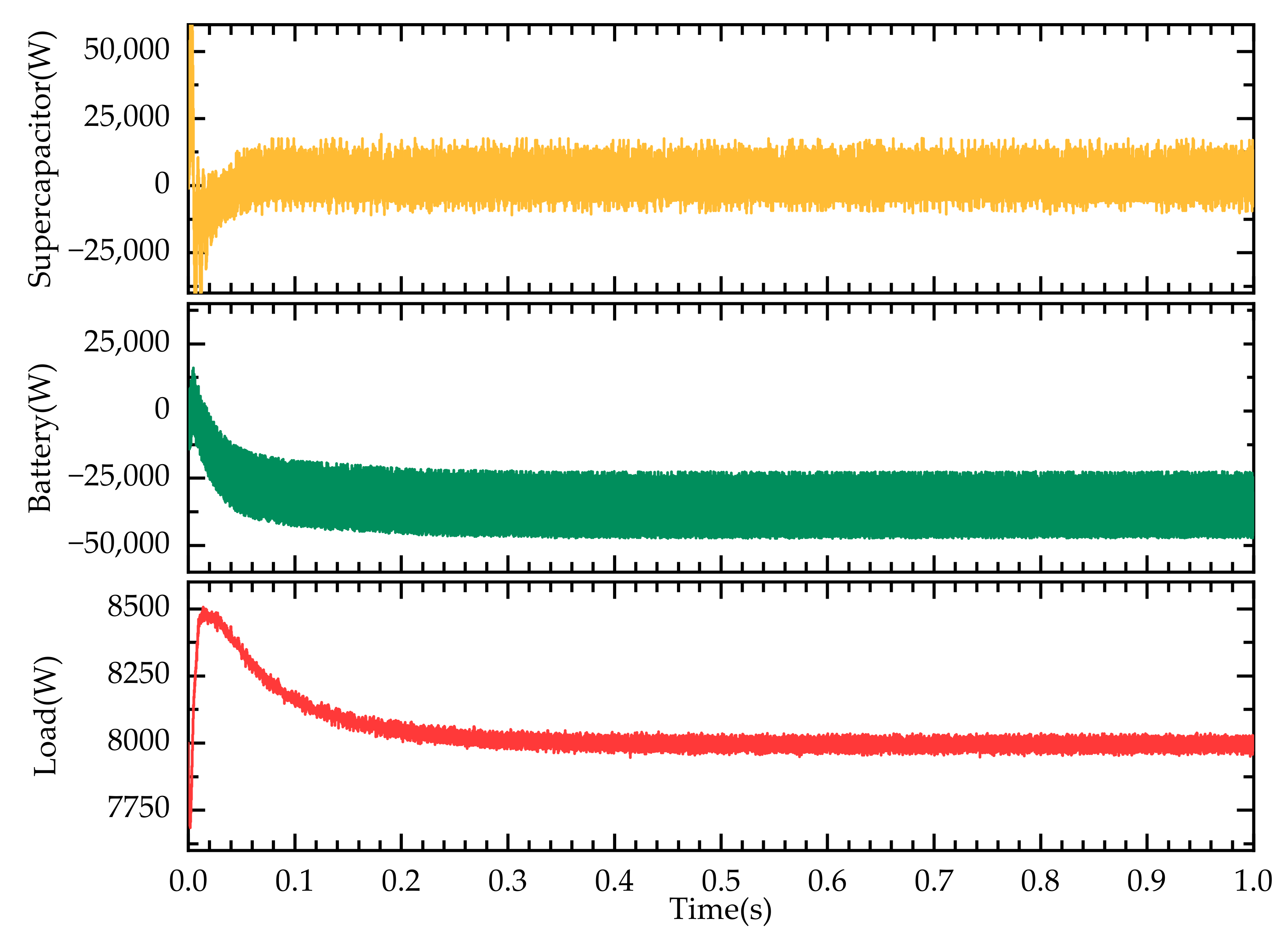


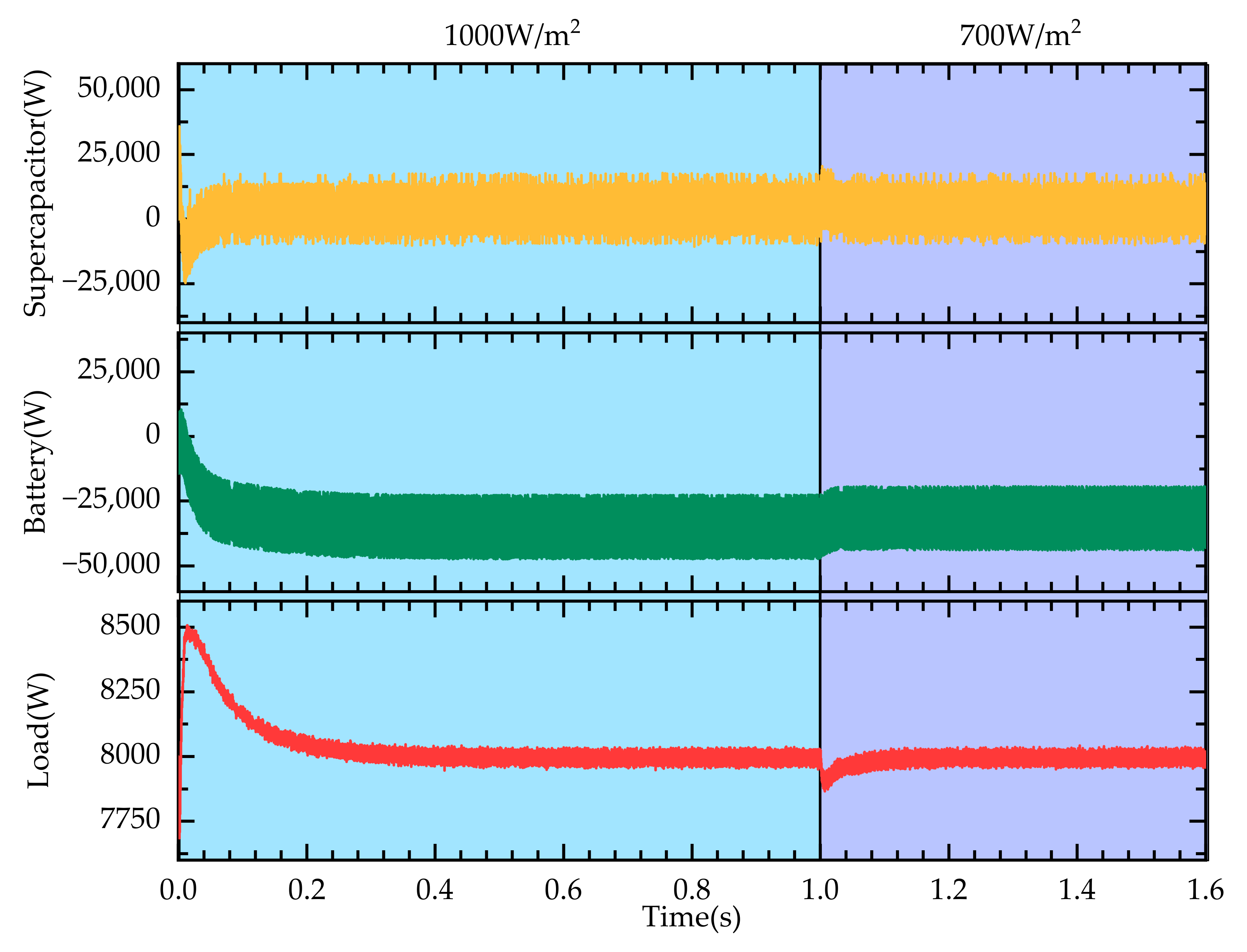
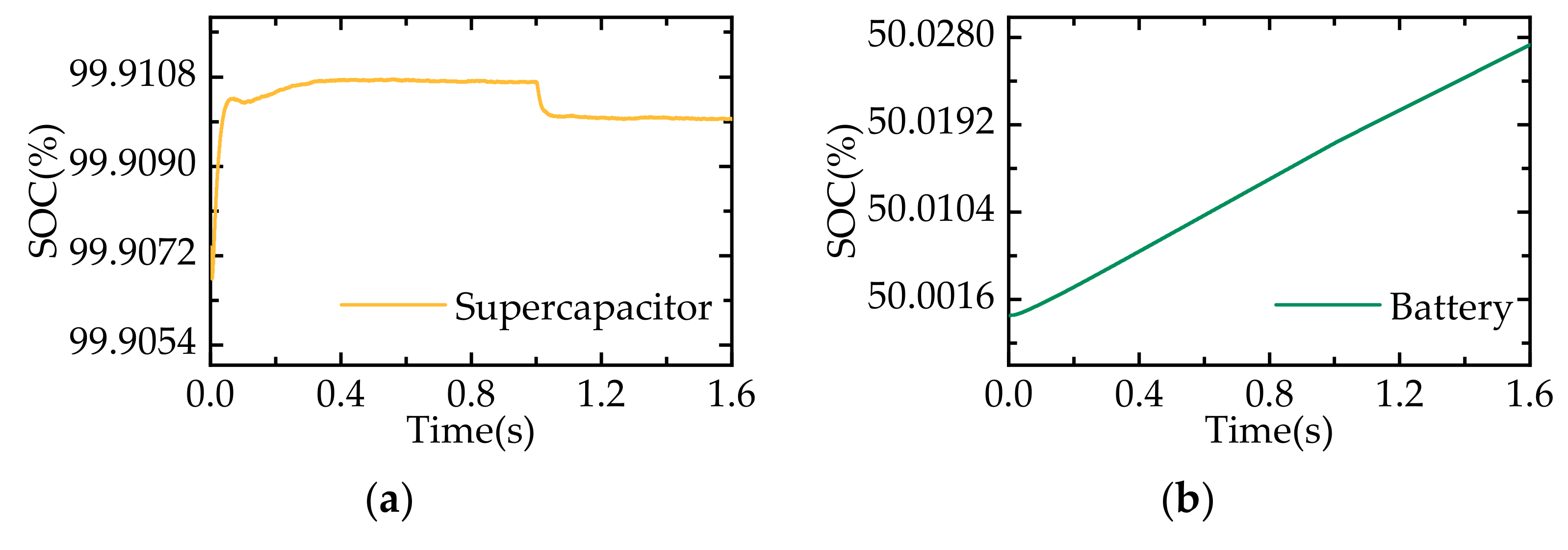

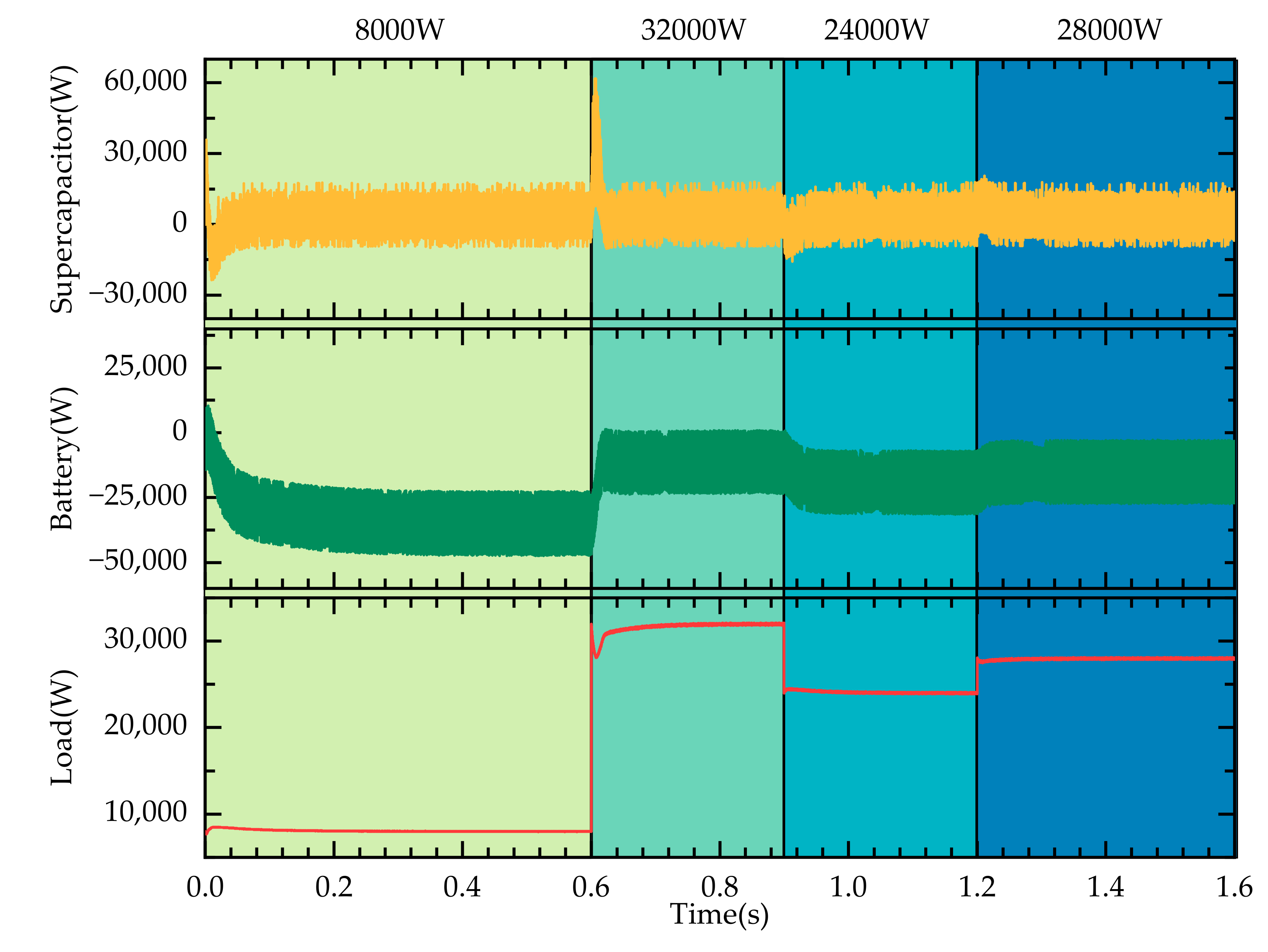

| Characteristics | Power-Type Devices | Energy-Type Devices |
|---|---|---|
| Typical representatives | Supercapacitors, flywheel energy storage, high-speed lithium batteries | Lithium-ion batteries, lead-acid batteries, flow batteries |
| Core advantages | High power density, short response time, long cycle life | High energy density, long-duration storage, low unit energy cost |
| Main limitations | Low energy density, high self-discharge rate | Power density limitations, low cycle life |
| Dynamic response capability | Milliseconds | Minutes to hours |
| Typical application scenarios | Voltage support, power compensation, renewable energy system | Peak shaving, smoothing output, backup power supply |
| System Module | Parameter | Value |
|---|---|---|
| DC microgrid | DC bus voltage | 700 V |
| Frequency | 50 Hz | |
| DC-side capacitor | 2200 μF | |
| DC load | Constant resistance | 61.25 Ω |
| Constant power | 8000 W | |
| PV array | Solar irradiance | 1000 W/m2 |
| Temperature | 25 °C | |
| Open-circuit voltage | 330 V | |
| Short-circuit current | 48 A | |
| Maximum power point voltage | 250 V | |
| Maximum power point current | 40 A | |
| Voltage compensation coefficient | −0.3564 | |
| Current compensation coefficient | 0.0537 | |
| Irradiance compensation coefficient | 0.5 |
| Mode | Simulation Time | Temperature | Solar Irradiance |
|---|---|---|---|
| Condition 1 | 0 s–1 s | 25 °C | 1000 W/m2 |
| Condition 2 | 0 s–1 s | 25 °C | 1000 W/m2 |
| 1 s–1.6 s | 25 °C | 700 W/m2 |
Disclaimer/Publisher’s Note: The statements, opinions and data contained in all publications are solely those of the individual author(s) and contributor(s) and not of MDPI and/or the editor(s). MDPI and/or the editor(s) disclaim responsibility for any injury to people or property resulting from any ideas, methods, instructions or products referred to in the content. |
© 2025 by the authors. Licensee MDPI, Basel, Switzerland. This article is an open access article distributed under the terms and conditions of the Creative Commons Attribution (CC BY) license (https://creativecommons.org/licenses/by/4.0/).
Share and Cite
Huang, B.; Song, K.; Zhang, T.; Lian, Z.; Li, H.; Jin, D.; Wang, R. Solving Power Supply Stability Issues in Remote Agricultural Areas Based on an Improved Sliding-Mode Active Disturbance Rejection Control Method. Agriculture 2025, 15, 674. https://doi.org/10.3390/agriculture15070674
Huang B, Song K, Zhang T, Lian Z, Li H, Jin D, Wang R. Solving Power Supply Stability Issues in Remote Agricultural Areas Based on an Improved Sliding-Mode Active Disturbance Rejection Control Method. Agriculture. 2025; 15(7):674. https://doi.org/10.3390/agriculture15070674
Chicago/Turabian StyleHuang, Boyan, Kai Song, Tao Zhang, Zihui Lian, Hongxu Li, Dezhi Jin, and Runjin Wang. 2025. "Solving Power Supply Stability Issues in Remote Agricultural Areas Based on an Improved Sliding-Mode Active Disturbance Rejection Control Method" Agriculture 15, no. 7: 674. https://doi.org/10.3390/agriculture15070674
APA StyleHuang, B., Song, K., Zhang, T., Lian, Z., Li, H., Jin, D., & Wang, R. (2025). Solving Power Supply Stability Issues in Remote Agricultural Areas Based on an Improved Sliding-Mode Active Disturbance Rejection Control Method. Agriculture, 15(7), 674. https://doi.org/10.3390/agriculture15070674






